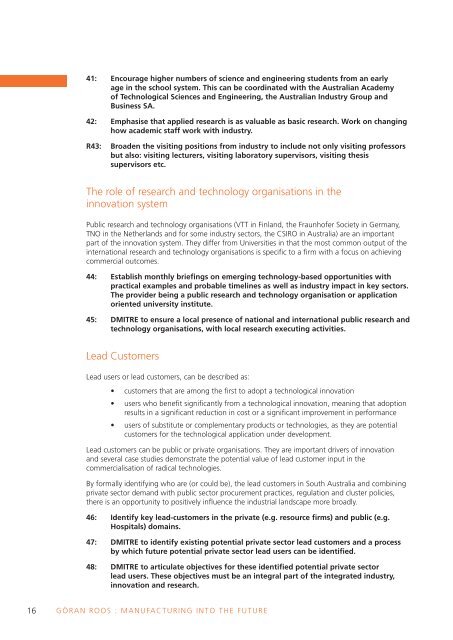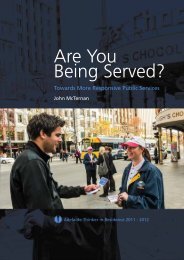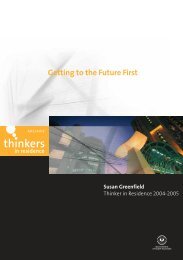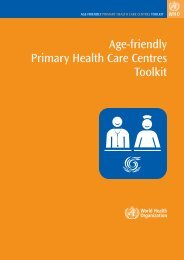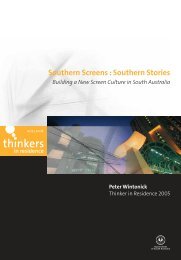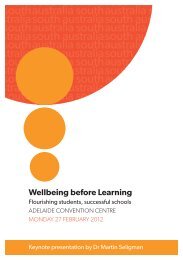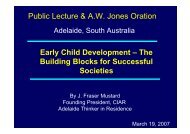Manufacturing into the future - Adelaide Thinkers in Residence - SA ...
Manufacturing into the future - Adelaide Thinkers in Residence - SA ...
Manufacturing into the future - Adelaide Thinkers in Residence - SA ...
- No tags were found...
You also want an ePaper? Increase the reach of your titles
YUMPU automatically turns print PDFs into web optimized ePapers that Google loves.
41: Encourage higher numbers of science and eng<strong>in</strong>eer<strong>in</strong>g students from an earlyage <strong>in</strong> <strong>the</strong> school system. This can be coord<strong>in</strong>ated with <strong>the</strong> Australian Academyof Technological Sciences and Eng<strong>in</strong>eer<strong>in</strong>g, <strong>the</strong> Australian Industry Group andBus<strong>in</strong>ess <strong>SA</strong>.42: Emphasise that applied research is as valuable as basic research. Work on chang<strong>in</strong>ghow academic staff work with <strong>in</strong>dustry.R43: Broaden <strong>the</strong> visit<strong>in</strong>g positions from <strong>in</strong>dustry to <strong>in</strong>clude not only visit<strong>in</strong>g professorsbut also: visit<strong>in</strong>g lecturers, visit<strong>in</strong>g laboratory supervisors, visit<strong>in</strong>g <strong>the</strong>sissupervisors etc.The role of research and technology organisations <strong>in</strong> <strong>the</strong><strong>in</strong>novation systemPublic research and technology organisations (VTT <strong>in</strong> F<strong>in</strong>land, <strong>the</strong> Fraunhofer Society <strong>in</strong> Germany,TNO <strong>in</strong> <strong>the</strong> Ne<strong>the</strong>rlands and for some <strong>in</strong>dustry sectors, <strong>the</strong> CSIRO <strong>in</strong> Australia) are an importantpart of <strong>the</strong> <strong>in</strong>novation system. They differ from Universities <strong>in</strong> that <strong>the</strong> most common output of <strong>the</strong><strong>in</strong>ternational research and technology organisations is specific to a firm with a focus on achiev<strong>in</strong>gcommercial outcomes.44: Establish monthly brief<strong>in</strong>gs on emerg<strong>in</strong>g technology-based opportunities withpractical examples and probable timel<strong>in</strong>es as well as <strong>in</strong>dustry impact <strong>in</strong> key sectors.The provider be<strong>in</strong>g a public research and technology organisation or applicationoriented university <strong>in</strong>stitute.45: DMITRE to ensure a local presence of national and <strong>in</strong>ternational public research andtechnology organisations, with local research execut<strong>in</strong>g activities.Lead CustomersLead users or lead customers, can be described as:• customers that are among <strong>the</strong> first to adopt a technological <strong>in</strong>novation• users who benefit significantly from a technological <strong>in</strong>novation, mean<strong>in</strong>g that adoptionresults <strong>in</strong> a significant reduction <strong>in</strong> cost or a significant improvement <strong>in</strong> performance• users of substitute or complementary products or technologies, as <strong>the</strong>y are potentialcustomers for <strong>the</strong> technological application under development.Lead customers can be public or private organisations. They are important drivers of <strong>in</strong>novationand several case studies demonstrate <strong>the</strong> potential value of lead customer <strong>in</strong>put <strong>in</strong> <strong>the</strong>commercialisation of radical technologies.By formally identify<strong>in</strong>g who are (or could be), <strong>the</strong> lead customers <strong>in</strong> South Australia and comb<strong>in</strong><strong>in</strong>gprivate sector demand with public sector procurement practices, regulation and cluster policies,<strong>the</strong>re is an opportunity to positively <strong>in</strong>fluence <strong>the</strong> <strong>in</strong>dustrial landscape more broadly.46: Identify key lead-customers <strong>in</strong> <strong>the</strong> private (e.g. resource firms) and public (e.g.Hospitals) doma<strong>in</strong>s.47: DMITRE to identify exist<strong>in</strong>g potential private sector lead customers and a processby which <strong>future</strong> potential private sector lead users can be identified.48: DMITRE to articulate objectives for <strong>the</strong>se identified potential private sectorlead users. These objectives must be an <strong>in</strong>tegral part of <strong>the</strong> <strong>in</strong>tegrated <strong>in</strong>dustry,<strong>in</strong>novation and research.16GÖRAN ROOS : MANUFACTURING INTO THE FUTURE


